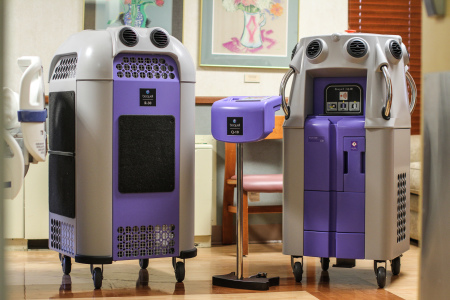The future is now. At least, that’s the case at Grinnell Regional Medical Center (GRMC), located one mile away from campus. Earlier this year, GRMC became the first hospital with fewer than 50 beds nationwide and the first of any size in Iowa to install disinfecting robots, designed to clean rooms more effectively than humans.

The robots are a product of the company Bioquell, whose website states that they are “world leaders in decontamination and infection control solutions using the latest hydrogen peroxide vapour technology.”
After a patient with an infectious disease stays at GRMC, a robot is placed in the room where the individual stayed. The room is then sealed off entirely and all surfaces are made accessible to the air; cabinets and drawers are opened, bedding removed, cushions shifted.
The robot then emits vapor that is 35 percent hydrogen peroxide that deeply cleans all surfaces. For comparison, the hydrogen peroxide liquid that can be bought at stores for in-home use is actually about only one percent hydrogen peroxide. Because of this, the vapor is dangerous and therefore should not be inhaled, but is incredibly effective.
“It really does completely fill the room,” said GRMC President and CEO Todd Linden. “So, hard to clean places like in the corners, behind the toilets, in cracks and crevices where sometimes it is harder to actually clean physically, the vapor really does do what we call a 99.9999 percent kill of the bacteria. That is the advantage of using this equipment. It does a more thorough job of making sure the bacteria is gone.”
A Johns Hopkins study discovered that this technology decreases the chances of a patient becoming ill with a new infection while staying at the hospital by 64 percent. However, this has not proven to be a glaring issue for GRMC. According to Linden, the hospital takes several measures to sterilize its rooms and has only had one such case where the patient became ill from a new infection since 2012.
“The Bioquell unit for us is just one more arrow in our quiver when it comes to making sure that our environment is as safe as it can possibly be,” Linden, who is also a Grinnell College Trustee, said.
The biggest reason for implementing the robots, according to Linden, is to combat the problem of antibiotic resistance, one of the most pressing health issues in America.
“We don’t have new antibiotics coming out that are showing efficacy in treating these infections, so we’ve got to really focus now on keeping people from getting infection in the first place,” Linden said.
Although these machines would be useful for combatting Ebola, they were installed in March, before the international Ebola crisis. Besides, Linden noted that there are other more pertinent enemies to combat than Ebola, specifically noting superbugs like MRSA, C. Diff and VRE.
“Obviously, in this country, just one person has died from Ebola. If we just have an average year in this country, 30,000 Americans will die from the flu. And we actually have a vaccine for that,” Linden said. “The Ebola issue is one that raises awareness for folks about infectious diseases and is certainly a reminder for those who work in healthcare that we’ve got to be vigilant about protecting both our employees and patients from infectious disease.”
GRMC also has further plans to prevent the spread of disease, specifically introducing copper to the hospital. Surfaces made from copper naturally kill bacteria, so the hospital has plans to replace stainless steel products such as light switches and toilet handles with copper ones. The hospital is currently working with Grinnell College students and a faculty member to research how effective this move would be.


















































